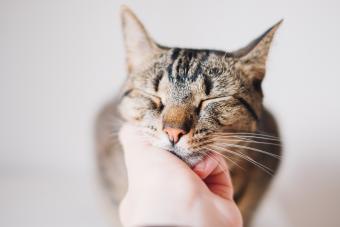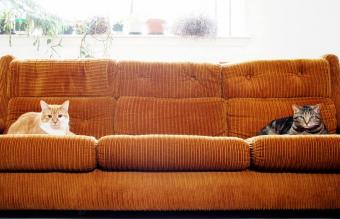
If your cat has been using your furniture or door trim to scratch, you can use a cat scratching deterrent to modify this behavior. Many experts recommend trying options other than declawing to deal with scratching, and the best deterrents can do the trick.
Cat Scratch Deterrent Options
If you can't get your cat to stop scratching items that she shouldn't, you can try covering her inappropriate scratching places with a scent or a texture that she doesn't like.
Double Stick Tape
Cats do not like stickiness on their feet. You can stick rows of double stick tape to the arms of sofas and other areas where your cat likes to scratch. Often the feel of the tape will be enough to discourage scratching. You should eventually be able to stop applying the tape once she has learned her lesson.
Aluminum Foil
Aluminum foil makes noise and most cats don't care for the feel or the sound of it. Some plastics or cellophane will also work. Cover off-limit areas with one of these deterrents to train your cat away from them.
Water Gun
You can deter your cat from scratching if you can catch her in the act and squirt her with either a spray bottle of water or the stream from a water gun. However, using punishment is not effective to modify behaviors and unless you are there for every single time she is scratching and you have excellent timing, using a water bottle or gun will not help. It can also cause your cat to become afraid of you and damage your relationship so it's best to avoid this traditional method.
Citrus Scents
Spraying citrus scents on the areas that you don't want your cat to scratch may also keep your pet from tearing up your furniture. Cats dislike the smell of citrus.
Homemade Cat Scratch Repellent
You can easily make a homemade scent solution to deter cats from scratching although as with any deterrent, its effectiveness will vary based on your consistency, your cat's desire to scratch and the amount of alternate avenues you provide for your cat to indulge in a natural, needed behavior.
- Take an empty water spray bottle and fill it with eight ounces of warm, but not hot, water.
- Add drops of an essential oil to the bottle. You want to aim for a mixture that is a ratio of one part oil for three parts water.
- You can use one oil or a combination of oils for your mixture. Use any oil that has a scent that cats are known to dislike. These include:
- Any citrus scent such as orange, lemon, or lemongrass
- Lavender
- Mint or peppermint
- Eucalyptus
- Cinnamon
- Wintergreen
- Citronella
- Rosemary
- You can also use white vinegar or apple cider vinegar instead of essential oils. For these use a ratio of 50% vinegar and 50% water.
- Mix the oils and water together with a spoon or close the bottle and shake it.
- Spray the area you wish to protect once a day and make sure you provide an excellent alternative nearby for the cat, such as a scratching post rubbed with catnip. You want to make it extremely obvious for the cat to want to choose one over the other.
- Another option, depending on your home setup, is to use one of the oils listed above in a diffuser and place it near the furniture. It will keep you from getting your furniture wet while infusing the area you want your cat to avoid with the scent and also has the added benefit of being an attractive item to decorate and humidify your home.
Offer an Alternative
You will probably need to try more than one cat scratching deterrent in order to find which one works best for you. Basically, you are looking for something your cat prefers to your chairs since she will use what appeals to her the most.
Cat Scratching Posts
Cats prefer scratching at rough bark, wood and things with texture, so make sure that any scratching post you choose is covered in something your cat will like.
- Sisal, burlap and carpet are all good covering choices.
- The post or cat tree should be at least two-and-a-half feet tall, or tall enough for the cat to stretch her body fully against it.
- It should be firmly affixed to a stable platform.
- Your cat will eventually shred any fabric used on the post, but you should not replace it. Cats prefer cottage chic.
- If you're handy, you can also make your own cat scratcher.

Rugs for Scratching
A rug can be perfect for your cat's need to scratch. The back side of a rug is usually attractive to your cat. You can often get discontinued carpet samples from flooring stores for a very low price or even for free. Just make sure the scratching rug is always kept in the same place so your cat doesn't confuse it with the rest of your carpeting.
Claw Covers
Another humane option is to have your cat's claws covered with plastic caps. Soft Paws are a product invented by a veterinarian to provide a safe alternative to declawing. The caps fit over the cat's nails, and it allows them to engage in stretching and scratching without the ability to destroy anything. Your veterinary clinic or a cat groomer can put the caps on for you if you can't do it yourself and you'll need to replace them about every four to eight weeks depending on your cat. Your cat's nails should be trimmed between applications to maintain proper nail health.
Natural Cat Scratching Behavior
Scratching is a natural behavior for cats. They do it for a few reasons.
- First of all, cats have glands between their toes. When a cat scratches something, this effectively marks the territory. In nature, a cat will scratch a tree trunk or some other item to leave its scent and let other cats know that the territory is taken.
- Cats also scratch as a natural way to groom their nails. As they scratch, old cells are shed and the nails are naturally trimmed. When a cat does this outside, it isn't necessarily a problem. It isn't until a cat has completely shredded the arms of your favorite chair that the scratching becomes something that needs to be dealt with.
- Finally, cats scratch to stretch and exercise.
Scratching is instinctive, so you will never be able to keep your cat from scratching things, but you can keep her from scratching important items using the deterrents and alternatives.

Punishment Doesn't Work
One thing to be aware of is that punishing your cat by swatting or yelling will not work. Your cat is not scratching due to bad behavior or a discipline problem. Scratching is an instinct, and you can't discipline instinct out of your cat. The best way to train her not to scratch is to provide her with an enjoyable alternative that fulfills her natural behavioral needs. By using textures your cat likes on the areas that you want her to scratch and using textures and scents that she doesn't like on the areas you want her to stay away from, you can encourage her to scratch in areas where she is permitted to carry out her natural urges.







